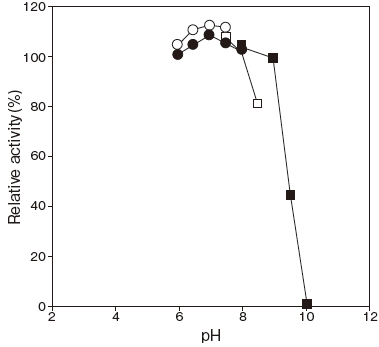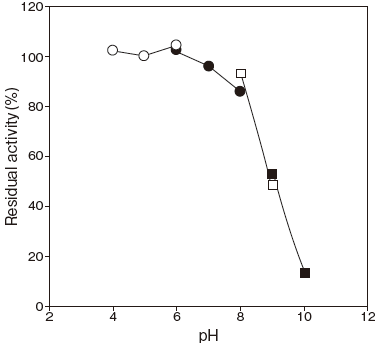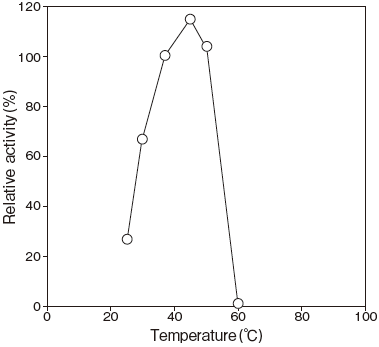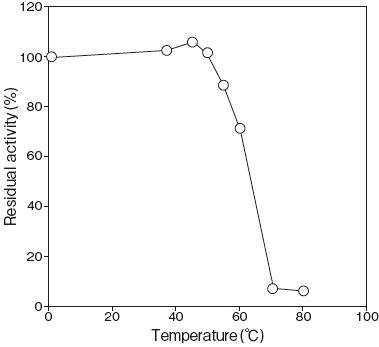CHOLESTEROL ESTERASE [CEBP–M]
from Microorganism
(Steryl-ester acylhydrolase, EC 3.1.1.13)
(Sterol esterase)
Cholesterol Ester + H2O → Cholesterol + Fatty Acid
High liquid stability
Preparation and Specification
- Appearance
- : White to off white lyophilized powder
- Specific activity
- : More than 10.0 U/mg solid
Properties
- Substrate specificity
- : See Table 1
- Molecular weight
- : 87 kDa (gel filtration)
62 kDa (SDS–PAGE)
- Isoelectric point
- : pH 5.0±0.2
- Optimum pH
- : 7.0Figure 1
- pH stability
- : 5.0–8.0 (37℃, 60 min) Figure 2
- Optimum temperature
- : 45℃ (Phosphate buffer) Figure 3
- Thermal stability
- : Stable at 55℃ and below (pH7.5, 10 min) Figure 4
- Liquid stability
- : See Figure 5
- Effect of metal ions
- : See Table 2
- Effect of detergents
- : See Table 3
Applications for Diagnostic Test
This enzyme is useful for enzymatic determination of total cholesterol,
This enzyme is suitable for assembling in liquid reagens.
| CEBP-M | ||
| Cholesterol ester + H2O | → | Cholesterol + FFA |
| CON Ⅱ | ||
| Cholesterol + O2 | → | △4 -Cholesten-3-one + H2O2 |
| POD | ||
| 2 H2O2 + 4-AA + Phenol | → | Quinoneimine dye + 4 H2O |
FFA: Free fatty acid
Table 1. Substrate specificity
| Substrate (0.95mM) | Relative activity (%) |
|---|---|
| Cholesterol acetate | 1.20 |
| Cholesterol propionate | 8.90 |
| Cholesterol butyrate | 17.7 |
| Cholesterol palmitate | 27.0 |
| Cholesterol stearate | 8.10 |
| Cholesterol oleate | 100 |
| Cholesterol linolate | 187 |
Table 2. Effect of metal ions on CEBP–M activity
| Metal ion | Relative activity (%) |
|---|---|
| None | 100 |
| NaCl (100mM) | 108 |
| KCl (100mM) | 106 |
| NH4Cl (100mM) | 100 |
| LiCl (100mM) | 96.9 |
| MgCl2 (1mM) | 99.5 |
| MnCl2 (1mM) | 125 |
| CoCl2 (1mM) | 96.4 |
| ZnCl2 (1mM) | 105 |
Table 3. Effect of detergents on CEBP–M activity
| Detergent | Relative activity (%) |
|---|---|
| None | 100 |
| Triton X–100 (0.1%) | 106 |
| Deoxycholic acid (0.05%) | 116 |
| SDS (0.05%) | 134 |
Fig.5 Stability of reconstituted CEBP-M
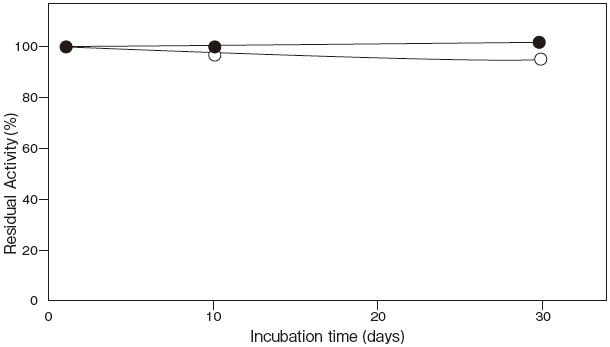
● : at 37℃
| Storage conditions | : | 0.5U/mI CEBP-M 50mM BES buffer pH 6.5 0.4% Triton X-100 0.05% NaN3 0.6mM ADOS 7.5U/mI POD |
Assay
Principle
-
The assay is based on the increase in absorbance at 493 nm as the formation of quinoneimine dye proceeds in the following reactions:
| CEBP–M | ||
| Cholesterol ester+H2O | → | Cholesterol+Fatty acid |
| CO | ||
| Cholesterol+O2 | → | △4–Cholesten–3–one+H2O2 |
| POD | ||
| 2 H2O2+4–AA+Phenol | → | Quinoneimine dye+4 H2O |
CO: Cholesterol oxidase
Unit definition
- One unit is defined as the amount of enzyme which liberates 1 μmole of cholesterol per minute at 37℃ under the conditions specified in the assay procedure.
Reagents
- Reaction mixture
0.2M KH2PO4–NaOH buffer pH 6.8
0.60 ml 0.35% 4–AA solution 0.30 ml 0.2% (W/V) Phenol solution 0.30 ml 100U/ml POD solution 1) 0.30 ml 3% (W/V) Triton X–100 solution 0.30 ml 0.2U/ml CONⅡ solution 2) 0.60 ml Substrate solution 3) 0.30 ml Distilled water 0.30 ml 1) : 100U/ml POD solution
Dissolve 1000 U (PPU) of POD with 10 ml of distilled water.2) : 0.2U/ml CONⅡ solution
Dissolve 2 U of CONⅡ with CONⅡ dilution buffer ※)※) : CONⅡ dilution buffer
0.1M KH2PO4–Na2HPO4 buffer pH 7.0 containing
0.05% (W/V) Triton X–100.3) : Substrate solution
Calf serum
- Enzyme dilution buffer
10mM KH2PO4–NaOH buffer pH 7.5 containing 0.1%
(W/V) BSA. - Reagents
Triton X–100: The Dow Chemical Company
CONⅡ : Asahi Kasei Pharma Corporation #T–84
Calf serum: GIBCO Co. (USA)
BSA: Millipore Fraction V pH5.2 #81–053
4–AA: NACALAI TESQUE, INC. Special grade#01907–52POD: Sigma Chemical Co. Type Ⅱ #P–8250
Enzyme solution
-
Accurately weigh about 20 mg of the sample and add
enzyme dilution buffer to make a total of 20 ml.Dilute it with enzyme dilution buffer to adjust the concentration to within 0.35 U/ml.
Procedure
- Pipette accurately 3.0 ml of reaction mixture into a small test tube and preincubate it at 37℃.
- After 10 min, add 50 μl of enzyme solution and mix to start the reaction at 37℃.
※ In the case of a test blank, add 50 μl of enzyme dilution buffer in place of enzyme solution. - After starting the reaction, measure the rate of increase per minute in absorbance at 493 nm. The rate must be measured within the linear portion of the absorbance curve.
-
△A/min = (As/min−Ab/min) ≦0.040 Abs/minAbsorbance sample : As/min blank : Ab/min
Calculation
-
Activity (U/mg of powder) = {(△ A/min)/(12.0 × 1/2)} × 3.05/0.05 × 1/x
12.0 : millimolar extinction coefficient of quinoneimine dye
at 493 nm (cm2/ μmole)1/2 : a multiplier derived from the fact that 2 mole of H2O2 produce 1 mole of quinoneimine dye 3.05 : final volume (ml) 0.05 : volume of enzyme solution (ml) X : concentration of the sample in enzyme solution ( mg/ml)
Storage
-
Storage at −20℃ in the presence of a desiccant is recommended.
References
- Bradford, M. B., (1976) Anal. Biochem., 72, 248–254.
- Allain, C. C., Poon, L. S., Chan, C. S. G., Richmond, W. and Fu, P.C. (1974) Clin. Chem., 20, 470–475.
- Kameno, Y., Nakano, N. and Baba, S. (1976) Jap. J. Clin. Path., 24, 650.
CEBP–M 活性測定法 (Japanese)
試薬液
- 反応試薬混合液
0.2M KH2PO4–NaOH 緩衝液 pH6.8
0.60 ml 0.35% 4–AA 溶液 0.30 ml 0.2% (W/V) フェノール溶液 0.30 ml 100U/ml POD 溶液 1) 0.30 ml 3% (W/V) トリトンX–100 溶液 0.30 ml 0.2U/ml CONⅡ溶液 2) 0.60 ml 基質溶液 3) 0.30 ml 精製水 0.30 ml 1) : 100U/ml POD 溶液
POD1,000 単位 (PPU) を精製水10ml で溶解する。2) :
0.2U/ml CONⅡ溶液
CONⅡ 2 単位 (U) をCONⅡ溶解用液※) 10ml で溶解する。※) : CONⅡ溶解用液
0.05% (W/V) トリトンX–100 を含む0.1M
KH2PO4–Na2HPO4 緩衝液 pH7.03) : 基質溶液
仔牛血清液 - 酵素溶解希釈用液
0.1% (W/V) BSA を含む10mM KH2PO4–NaOH 緩衝液 pH7.5 - 試薬
トリトンX–100:Dow Chemical 製
CONⅡ (コレステロール酸化酵素) :旭化成ファーマ製 #T–84仔牛血清液 (Calf serum) : GIBCO (USA) 製
BSA: Millipore 製 Fraction V pH5.2 #81–053
POD:シグマ製 Type Ⅱ #P–8250
- 4–AA:ナカライテスク製 特級 #01907–52
酵素試料液
- 検品約20mg を精密に量り、酵素溶解希釈用液に溶解して全容20ml とする。
その液を酵素溶解希釈用液で約0.35U/ml 濃度となるように適宜希釈する。
測定操作法
- 小試験管に反応試薬混合液を3.0ml 正確に分注して37℃で予備加温する。
- 10 分経過後、酵素試料液50 μl を正確に加えて混和し、37℃で反応を開始する。
※ 盲検は酵素試料液の代わりに酵素溶解希釈用液50μl を加える。 - 反応開始後、493nm における吸光度を測定して直線的に反応している1 分間当たりの吸光度変化を求める。
求められた吸光度変化を試料液はAs/min、盲検液は
Ab/min とする。
Δ A/min = (As/min−Ab/min) ≦ 0.040Abs/min
計算
以下の計算式に従い、活性 (U/mg) を計算する。活性 (U/mg) = {(△ A/min)/(12.0 × 1/2)} × 3.05/0.05 × 1/x
| 12.0 : | キノンイミン色素の493nm におけるミリモル 分子吸光係数 (cm2 / μmol) |
| 1/2 : | H2O22 モルからキノンイミン色素1 モルが生成することによる係数 |
| 3.05 : | 反応総液量 (ml) |
| 0.05 : | 反応に供した酵素試料液量 (ml) |
| X : | 酵素試料液中の検品濃度 (mg/ml) |




